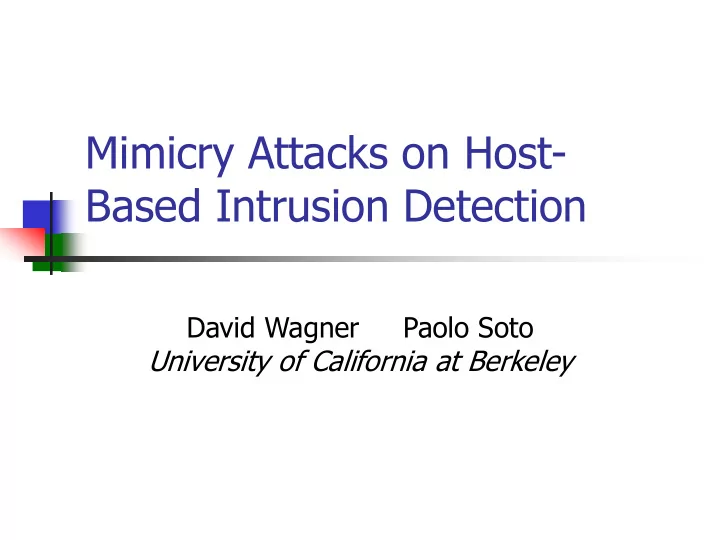

Mimicry Attacks on Host- Based Intrusion Detection David Wagner Paolo Soto University of California at Berkeley
Preview The topic of this talk: How do we evaluate the security of a host-based IDS against sophisticated attempts to evade detection? One answer: “adversarial scholarship”
The Cryptographer’s Creed Conservative design Systems should be evaluated by the worst failure that is at all plausible under assumptions favorable to the attacker * Kerkhoff’s principle Systems should remain secure even when the attacker knows all internal details of the system The study of attacks We should devote considerable effort to trying to break our own systems; this is how we gain confidence in their security * Credits: Gwyn
Research Into Attacks Design Attacks Block ciphers 81 100 Intrusion detection 120 7 Table 1. Papers published in the past five years, by subject. We could benefit from a stronger tradition of research into attacks on intrusion detection
In This Talk… How do we evaluate the security of a host-based IDS against sophisticated attempts to evade detection? Organization of this talk: Host-based intrusion detection Mimicry attacks, and how to find them Attacking pH, a host-based IDS Concluding thoughts
Host-based Intrusion Detection Anomaly detection: IDS monitors system call App allowed trace from the app traces DB contains a list of subtraces that are allowed to appear IDS Any observed subtrace not in DB sets off alarms Operating System
The Mimicry Attack 1. Take control of the app. App allowed e.g., by a buffer overrun traces 2. Execute payload while mimicking normal app behavior. malicious If exploit sequence IDS payload contains only allowed subtraces, the intrusion will remain undetected. Operating System
When Are Attacks Possible? The central question for mimicry attacks: Can we craft an exploit sequence out of only allowed subtraces and still cause any harm? Assumptions: IDS algorithm + DB is known to attacker [Kerkhoff ] Can take control of app undetected [Conservative design ]
Disguising the Payload Attacker has many degrees of freedom: Wait until malicious payload would be allowed Vary the malicious payload by adding no-ops e.g., (void) getpid() or open(NULL,0) In fact, nearly all syscalls can be turned into no-ops Note: the set of choices can be expressed as a regexp Let N denote the set of no-op-able syscalls Then open() write() can be replaced by anything matching N * open() N * write() N *
A Theoretical Framework To check whether there is a mimicry attack: Let Σ = set of security -relevant events, M = set of “bad” traces that do damage to the system, A = set of traces allowed by the IDS ( M , A Σ*) If M A Ø, then there is a mimicry attack M A
A Theoretical Framework To check whether there is a mimicry attack: Let Σ = set of security -relevant events, M = set of “bad” traces that do damage to the system, A = set of traces allowed by the IDS ( M , A Σ*) If M A Ø, then there is a mimicry attack M A Then just apply automata theory M : regular expression (regular language) A : finite-state system (regular language) Works since IDS’s are typically just finite -state machines
Experience: Mimicry in Action The experiment: pH: a host-based IDS [SF00] autowux: a wuftpd exploit No mimicry attacks with the original payload … but, after a slight modification …
A Successful Mimicry Attack We found a modified payload that raises no alarms and has a similar effect on the system pH may be at risk for mimicry attacks
Conclusions Mimicry attacks: A threat to host-based IDS? Practical implications not known The study of attacks is important Unfortunately, there’s so much we don’t know…
Recommend
More recommend